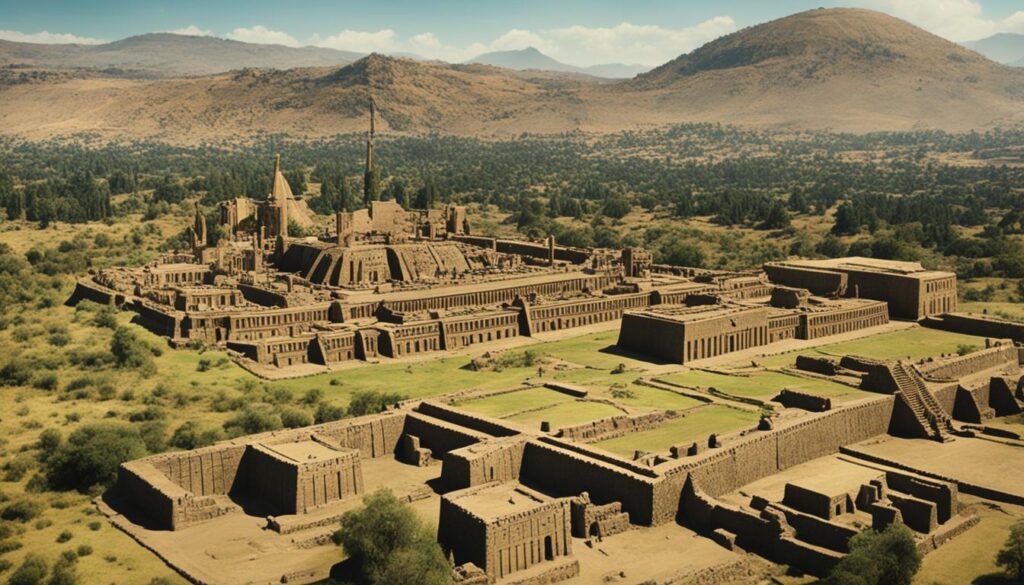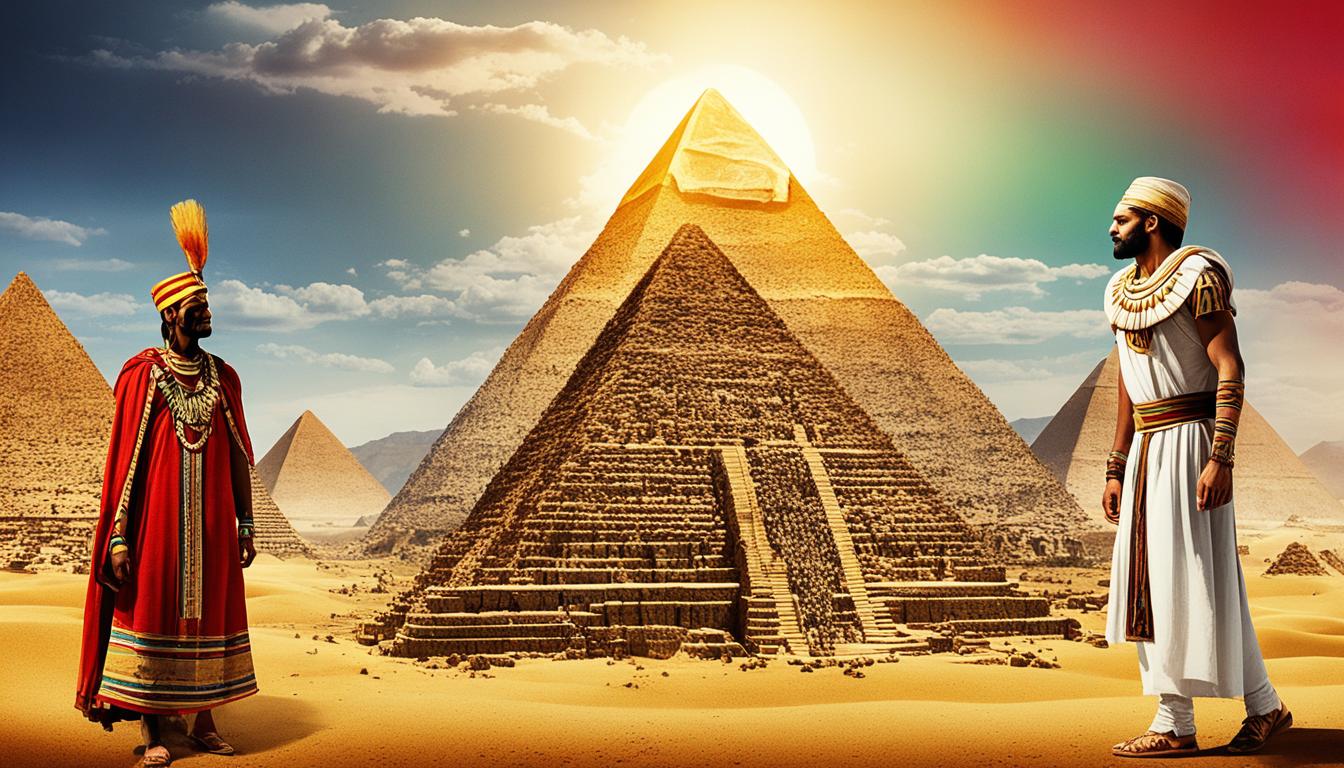Is Ethiopia Older Than Egypt?
Did you know that Ethiopia has the longest archaeological record of any country in the world, dating back over 5 million years? This surprising fact challenges the commonly held notion that Egypt is the cradle of civilization in Africa. While Egypt is renowned for its complex politico-religious system and well-preserved ancient artifacts, Ethiopia’s ancient civilization is primarily attested through its archaeological remains.
While Egyptian records meticulously document their kings and chronology, Ethiopian records have either been lost or not yet discovered. The ancient city of Axum, the capital of Ethiopia, was founded a millennium after the reign of King Solomon in the 10th century BC. However, Ethiopia’s rich archaeological record reveals a history that spans millions of years and includes evidence of early hominids and sophisticated civilizations.
Key Takeaways:
- Ethiopia has the longest archaeological record of any country, dating back over 5 million years.
- Egypt is known for its well-preserved ancient artifacts, but Ethiopia’s civilization is primarily attested through archaeological remains.
- The ancient city of Axum was founded a thousand years after the reign of King Solomon.
- Ethiopia’s archaeological record includes evidence of early hominids and evidence of sophisticated civilizations.
- Despite the debate, Ethiopia’s rich cultural heritage and ancient wonders continue to fascinate and attract visitors from around the world.
The Ancient Origins of Ethiopia
Ethiopia has the longest archaeological record of any country in the world, dating back over 5 million years. The remains of the earliest ancestral humans, known as Australopithecus Afarensis, have been found in Ethiopia’s Omo Valley and the Afar Depression.
While the Ethiopian highlands developed sophisticated civilizations, many parts of the country retained a hunter-gatherer lifestyle similar to our ancestral hominids. Ethiopia’s archaeological sites in the Omo Valley and Danakil Depression are key areas for the study of human evolution and the ancient history of the region.
The country’s rich cultural heritage is also noteworthy, with unique traditions and religious practices that have been passed down through generations.
We are fascinated by the ancient origins of Ethiopia and the diverse civilizations that have shaped its history.
As we explore ancient Ethiopia, let’s delve into the comparisons between Ethiopian civilization and its Egyptian counterpart.
The Antecedents of Axum

Ethiopia’s history is deeply rooted in ancient times, with evidence of Stone Age tools and cave paintings showcasing the industriousness of its earliest inhabitants. During the Chalcolithic Age from 6200 to 3000 BC, the people of Ethiopia began cultivating grains and crops that still form the foundation of the country’s agriculture today.
Indigenous Ethiopians had regular interactions with their neighboring civilizations, and the Red Sea served as a vital trade route connecting different cultures. The Ancient Egyptians documented their voyages to the region known as the Land of Punt, which is believed to refer to ancient Ethiopia.
In various traditions, including Ethiopian, Yemeni, and biblical accounts, the Queen of Sheba is mentioned. She is believed to have lived around the 10th century BC, overlapping with the reign of King Solomon. However, archaeological evidence suggests that the site of Axum, the ancient capital of Ethiopia, was not settled until a thousand years after this period.
“Ethiopia’s history is deeply rooted in ancient times, with evidence of Stone Age tools and cave paintings showcasing the industriousness of its earliest inhabitants.”
While Egypt is often discussed in relation to its well-documented ancient civilization, Ethiopia’s history encompasses a broader timeframe with various influences from neighboring civilizations as well as its own unique development. The timeline of Ethiopia and Egypt follows different trajectories, with Ethiopia’s roots reaching back further into prehistoric times. Understanding the ancient history of Ethiopia provides valuable insights into the diverse cultures and civilizations that have shaped the region.
The Rise and Fall of Axum

Axum, the most celebrated state of ancient Ethiopia, rose to power in the first century CE and reached its zenith in terms of grandeur and influence. The Axumite Empire stretched from Nubia to Yemen and Hejaz, encompassing much of the Horn of Africa.
The empire maintained a monopoly over the spice and incense trade, collaborating with the Nabateans and southern Arabians. Axum’s rulers assumed the title of “Negust Nagast,” meaning “King of Kings,” and minted coins that provide valuable insights into the empire’s political structure, religion, and culture.
“Negust Nagast, meaning ‘King of Kings,’ minted coins.”
The monumental stelae of Axum, marking the burial catacombs of the Axumite kings, are among the most imposing features of the empire’s material culture. These towering structures, some of which reach over 30 meters in height, serve as lasting reminders of the empire’s grandeur and architectural prowess.
Despite its grandeur, the empire eventually faced challenges that led to its decline. The rise of Islam in the Arabian Peninsula disrupted the commercial dominance of Axum, causing a loss of trade routes and economic power in the region.
“The rise of Islam in the Arabian Peninsula disrupted Axum’s commercial dominance.”
Nevertheless, the significance of Axum and its cultural achievements endure, leaving a lasting legacy in Ethiopia’s rich historical tapestry.
| Axumite Empire | Egyptian Civilization |
|---|---|
| Reached its zenith in the first century CE | Flourished from around 3150 BCE to 30 BCE |
| Controlled the spice and incense trade, collaborating with neighboring regions | Known for complex politico-religious system and extensive record-keeping |
| Minted coins portraying rulers and providing insights into the empire’s culture | Well-preserved ancient artifacts revealing detailed records of kings and chronology |
| Monumental stelae marking the burial catacombs of Axumite kings | Pyramids and temples showcasing grand architectural achievements |
Ethiopia’s Enduring Cultural Heritage
The Influence of Ancient History
Ethiopia’s rich cultural heritage is deeply intertwined with its ancient history. Throughout the centuries, this diverse country has been shaped by a multitude of ethnic groups, each contributing their own unique traditions and customs. From the ancient civilizations that once thrived on the Ethiopian highlands to the influences of various religions such as Christianity and Islam, Ethiopia’s cultural tapestry is a testament to its rich past.
The Ethiopian Orthodox Church
One of the most prominent aspects of Ethiopia’s cultural heritage is the Ethiopian Orthodox Church. With origins dating back to the 4th century CE, this ancient Christian faith holds a significant place in both the religious and cultural life of the country. The Ethiopian Orthodox Church is renowned for its ancient monastic traditions, vibrant religious festivals, and breathtaking rock-hewn churches.
“Ethiopia has served as a bastion of Christianity for centuries, with the Ethiopian Orthodox Church acting as a custodian of our ancient traditions and a source of spiritual guidance.”
Culinary Traditions and Flavors
Ethiopian cuisine is a reflection of both its diverse agricultural practices and culinary traditions. Known for its bold flavors and unique cooking techniques, Ethiopian dishes have gained popularity worldwide. Injera, a sour pancake-like bread, is a staple in Ethiopian cuisine and is often used as a base for various stews and dishes. The traditional coffee ceremony, a cherished cultural tradition, showcases the significance of coffee in Ethiopian culture.
Preserving the Past, Celebrating the Present
As Ethiopia continues to embrace modernity, it also places great importance on preserving its ancient cultural heritage. Museums and historical sites across the country showcase artifacts and monuments that provide insights into Ethiopia’s ancient civilizations. Additionally, traditional music, dance, and artistic expressions continue to flourish, providing a vibrant and dynamic cultural scene.
| Ancient Egypt | Ancient Ethiopia |
|---|---|
| Well-documented records of kings and chronology | Limited written records; reliance on archaeological evidence |
| Complex politico-religious system | Diverse ethnic groups with unique traditions |
| Well-preserved artifacts | Archaeological remains attesting to ancient civilization |
| Known for pyramids and pharaohs | Axumite Empire and rock-hewn churches |
Exploring Ethiopia’s Ancient Wonders
Ethiopia is home to a plethora of ancient wonders that captivate travelers from around the world. These historical treasures offer a glimpse into the rich cultural heritage and architectural marvels that define Ethiopia’s past. Let’s take a closer look at some of these magnificent sites:
“Ethiopia boasts several ancient wonders that attract travelers from around the world.”
Lalibela’s Rock-Hewn Churches
A UNESCO World Heritage site, Lalibela is renowned for its extraordinary rock-hewn churches. Carved out of solid rock formations, these remarkable churches date back to the 12th century. The architectural ingenuity and religious significance of these structures make them a must-visit for history enthusiasts.
The Ancient City of Aksum
Aksum, an ancient city in Ethiopia, offers a glimpse into the grandeur of the Axumite Empire. The towering stelae and ruins scattered throughout the city bear witness to the empire’s past glory. Some of the monolithic obelisks in Aksum reach heights of over 30 meters, making them among the largest ever quarried in the ancient world.
Other Notable Ancient Sites in Ethiopia
Ethiopia is replete with historical sites that provide insights into its rich heritage. Here are a few more destinations worth exploring:
- Gondar: Known for its medieval castles and royal enclosure, Gondar offers a glimpse into Ethiopia’s imperial past.
- Lake Tana: The largest lake in Ethiopia, Lake Tana is dotted with picturesque island monasteries dating back centuries.
- Harar: An ancient walled city, Harar is known for its Islamic architecture and vibrant cultural heritage.
In conclusion, Ethiopia’s ancient wonders offer a fascinating journey through time. From the awe-inspiring rock-hewn churches of Lalibela to the grandeur of the Axumite Empire in Aksum, these historical sites showcase the rich history and cultural diversity of Ethiopia.
Conclusion
While the question of whether Ethiopia is older than Egypt may not have a straightforward answer, the historical dating and rich cultural heritage of Ethiopia highlight its significance in the ancient world. With an impressive archaeological record dating back over 5 million years, Ethiopia holds the distinction of having the longest archaeological record of any country.
A prominent ancient civilization in Ethiopia was the Axumite Empire, which flourished from the first century CE and reached its peak in terms of grandeur and influence. The architectural wonders of Axum, including the rock-hewn churches of Lalibela and the towering stelae, provide a glimpse into the past and evoke a sense of awe. These ancient structures and cultural traditions continue to captivate visitors, offering a unique journey through time.
Whether exploring the ancient wonders of Ethiopia, such as Lalibela, Axum, or the vibrant markets of Addis Ababa, travelers can gain a deeper understanding of the ancient world and witness the enduring legacy of Ethiopia’s historical dating. The rich cultural heritage of Ethiopia, combined with its archaeological treasures, make it a fascinating destination for those seeking to unearth the mysteries of the past.




